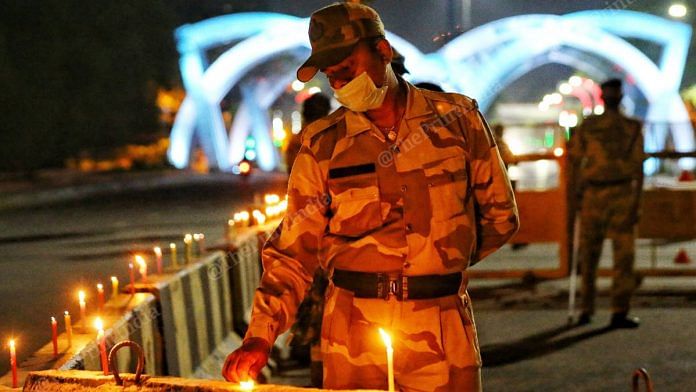On Monday’s front pages, cheerful snapshots of Sunday’s ‘diya jalaao’ are a stark contrast to the grim headlines about the rising coronavirus death toll in India and the surge in cases.
And, in an unusual move, The Indian Express and The New Indian Express feature pieces by ex-RBI governors Urjit Patel and Raghuram Rajan, respectively, on their front pages, for expert opinion on the situation.
Newspapers also note India’s changing stance on supplying anti-malaria drug, hydroxychloroquine to US, following PM Modi and US President Trump’s phone conversation.
Pink papers note that states are asking the Centre for financial lifelines and seeking compensation for declining GST revenues.
Most ominously of all, Mumbai Mirror, Mint and Business Standard call Mumbai’s Dharavi, Asia’s largest slum, a “ticking time bomb” with regard to the potential spread of Covid-19.
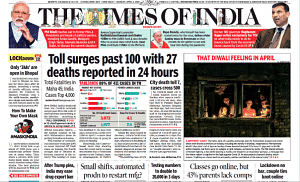 Before coming to the news on the front page, The Times Of India, has an entire tutorial on how to make your own mask at home.
Before coming to the news on the front page, The Times Of India, has an entire tutorial on how to make your own mask at home.
The lead story, ‘Toll surges past 100 with 27 deaths reported in 24 hours’, says, “India’s death toll from the Covid-19 outbreak surged past 100 to 124 with 27 more patients succumbing to the infection — according to official state-wise reports — the highest number so far, with Maharashtra alone reporting 13 deaths on Sunday.”
Sunday’s 9 minutes at 9 pm diya ceremony is commemorated by the daily with a photograph of a family lighting candles, captioned, ‘That Diwali Feeling in April’.
In heartening news, the government has heeded the call for more tests — ‘Testing numbers to double to 20,000 in 3 days’. According to TOI, “The government plans to double after every three days the number of samples tested through RT-PCR process — considered mandatory for accurate results — by government laboratories… Currently, labs under the ICMR are testing over 10,000 samples a day. This is expected to reach 20,000 in three days.”
And, “India is ‘considering’ a request by US President Donald Trump to relax the ban on export of hydroxychloroquine, the anti-malaria drug, which, as Trump has claimed, can help treat Covid-19 patients”.
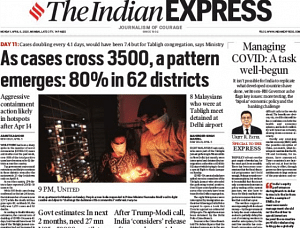 In its lead, The Indian Express analyses the spread of the coronavirus — ‘As cases cross 3500, a pattern emerges: 80 per cent in 62 districts’. It says, according to the government, restrictions across 62 districts that collectively account for 80 per cent of the total Covid-19 cases in India are “likely to continue… even after the nationwide 21-day lockdown ends on April 14.”
In its lead, The Indian Express analyses the spread of the coronavirus — ‘As cases cross 3500, a pattern emerges: 80 per cent in 62 districts’. It says, according to the government, restrictions across 62 districts that collectively account for 80 per cent of the total Covid-19 cases in India are “likely to continue… even after the nationwide 21-day lockdown ends on April 14.”
And some people just don’t know how to be responsible: In ‘8 Malaysians who were at Tablighi meet detained at Delhi airport’, says the eight Malaysians were trying to board a flight home, when they were nabbed by the authorities.
A two-column piece by ex-RBI Governor Urjit Patel (‘Managing COVID: A task well-begun’) on India’s policy response to the Covid-19 outbreak features on the front page. He calls for more testing and discusses India’s “bipolar economic policy” as well as the banking challenge (See ThePrint’s ThoughtShot for more details).
Another report notes a shocking incident where, despite calls for social distancing, 200 people gathered outside the residence of Nagpur BJP MLA Dadarao Keche in Wardha (‘In midst of lockdown, 200 celebrate BJP MLA’s birthday’).
Another report gives you an idea of the enormity of the challenges ahead: ‘Govt estimates…’ says that according to sources, the Centre has “calculated that the country will require about 27 million N95 masks, 15 million PPEs, 1.6million diagnostic kits, and 50,000 ventilators in next two months”.
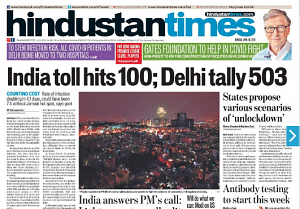 In a lead similar to TOI, Hindustan Times reports ‘India toll hits 100; Delhi tally 503’. According to the daily, “Sixteen fresh deaths and 514 new infections were reported on Sunday, the 12th day of a national lockdown that has been put in place to break the chain of infections. ‘Our focus is that we chase the virus, rather than the virus chasing us,’ health ministry joint secretary Lav Agarwal said during a news briefing.”
In a lead similar to TOI, Hindustan Times reports ‘India toll hits 100; Delhi tally 503’. According to the daily, “Sixteen fresh deaths and 514 new infections were reported on Sunday, the 12th day of a national lockdown that has been put in place to break the chain of infections. ‘Our focus is that we chase the virus, rather than the virus chasing us,’ health ministry joint secretary Lav Agarwal said during a news briefing.”
The second lead story, ‘States propose various scenarios of ‘unlockdown’’ says that officials in multiple states offered some pointers about how a staggered return to normal activity could work after April 15. “Officials in three states — Rajasthan, Maharashtra and Haryana — said they were in favour of first relaxing curbs in districts that are at present free of infections”. Punjab will most probably continue with the lockdown in most parts while in Uttar Pradesh, “agricultural and allied industries are likely to be allowed to resume”, it says.
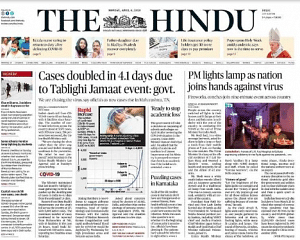 By its standards, The Hindu has a bold lead headline: ‘Cases doubled in 4.1 days due to Tablighi Jamaat event: govt’. The report states the meeting “pushed up the doubling rate to 4.3 days from the estimated 7.4 days..’’ Also, according to the Centre, there is “no evidence to suggest airborne transmission…’’
By its standards, The Hindu has a bold lead headline: ‘Cases doubled in 4.1 days due to Tablighi Jamaat event: govt’. The report states the meeting “pushed up the doubling rate to 4.3 days from the estimated 7.4 days..’’ Also, according to the Centre, there is “no evidence to suggest airborne transmission…’’
Hindu is also the only mainstream newspaper to mention in its headline that ‘PM lights lamp…’ on Sunday, as “People across the country switched off lights… and lit lamps at their doors…”
The other important story here is from Lucknow, where the chief minister had an important announcement: ‘U.P lockdown to end in phases: Adityanath’. He said that the complete lockdown will end on 15 April but the easing of restrictions will be in “phases’’. The paper reports that he said the virus needs to be fully defeated by November-December.
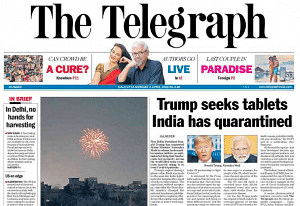 The Telegraph’s front page photo is of a firecracker being burst during ‘diya jalaao’ in Dum Dum park in Kolkata. This comes after reports of many instances of crackers being burnt throughout the country.
The Telegraph’s front page photo is of a firecracker being burst during ‘diya jalaao’ in Dum Dum park in Kolkata. This comes after reports of many instances of crackers being burnt throughout the country.
The Kolkata daily still manages to be witty with its headlines in dire times — `Trump seeks tablets India has quarantined’. The report says, “Trump’s request during a phone call to Modi was made on the same day India tightened rules banning the export of hydroxychloroquine. The export ban, without exceptions, came after the Union health ministry changed the national treatment guidelines to include a regimen of hydroxychloroquine and azithromycin to treat Covid-19 patients.”
The paper goes from witty to gloomy with the story, ‘Dreze and Rajan see dark clouds, list options’. Telegraph reports, “The Indian macroeconomic situation is bleak and, economically, the country is facing possibly its greatest emergency since Independence, renowned economists Jean Dreze and Raghuram Rajan have said. In a blog, Rajan said the country needed to plan for the post-lockdown phase…. Dreze, the Belgian-born Indian economist, told PTI in an interview on Sunday: ‘The situation is bleak and all set to get worse, if local or national lockdowns of varying intensity continue for some time…. Even otherwise, the worldwide recession is likely to have adverse effects on the Indian economy’.”
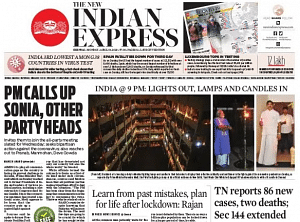 In a totally different lead here, “PM calls up Sonia, other party heads”, The New Indian Express observes PM Modi’s efforts to engage with various political parties and opposition leaders to strategise on the Covid-19 situation. In what is a good move, the newspaper notes, “Modi appears to be keen that the country puts up a united fight against the pandemic’’.
In a totally different lead here, “PM calls up Sonia, other party heads”, The New Indian Express observes PM Modi’s efforts to engage with various political parties and opposition leaders to strategise on the Covid-19 situation. In what is a good move, the newspaper notes, “Modi appears to be keen that the country puts up a united fight against the pandemic’’.
NIE also carries a report on former RBI governor Raghuram Rajan’s blog, which was posted on his LinkedIn page. In ‘Learn from past mistakes, plan for life after lockdown’, Rajan writes: “Once India wins the battle against COVID-19, there will be a bigger war waiting — fixing the large-scale disruption caused by the unprecedented shutdown”.
The paper’s anchor story ‘Early trends on fatality show the spread is uneven’ analyses the deaths due to Covid-19 in India. It notes, “At 16.6 per cent, the percentage of people who lost their lives due to the infection is the highest in Himachal Pradesh followed by Gujarat at 9.5 per cent”. On the other hand, Rajasthan has over 200 cases but no fatality while Kerala and Maharashtra have the highest number of cases but the fatality rate is well under 1 per cent. Experts say that this may be due to different steps taken by different states, with some testing and treating more.
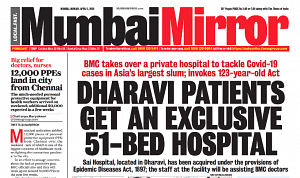 Mumbai Mirror has some reassuring news Monday — ‘DHARAVI PATIENTS GET AN EXCLUSIVE 51-BED HOSPITAL’. According to the paper, “To tackle the spread of coronavirus in Dharavi, the BMC on Sunday took over the entire 51-bed privately owned Sai Hospital in Dharavi to turn it into an isolation-cum-treatment centre. On Sunday evening, the total number of positive cases in Asia’s largest slum stood at five.”
Mumbai Mirror has some reassuring news Monday — ‘DHARAVI PATIENTS GET AN EXCLUSIVE 51-BED HOSPITAL’. According to the paper, “To tackle the spread of coronavirus in Dharavi, the BMC on Sunday took over the entire 51-bed privately owned Sai Hospital in Dharavi to turn it into an isolation-cum-treatment centre. On Sunday evening, the total number of positive cases in Asia’s largest slum stood at five.”
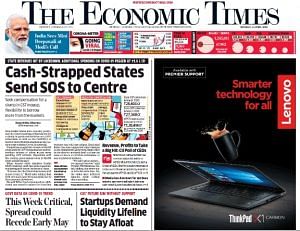 The Economic Times leads with news on the financial desperation of states. In ‘Cash-Strapped States Send SOS to Centre’, it notes that states like Punjab have sought compensation for the dip in GST collections and more “flexibility on borrowing” so that they can cope with the coronavirus outbreak.
The Economic Times leads with news on the financial desperation of states. In ‘Cash-Strapped States Send SOS to Centre’, it notes that states like Punjab have sought compensation for the dip in GST collections and more “flexibility on borrowing” so that they can cope with the coronavirus outbreak.
Appeals for a “lifeline” are also coming from start-ups, as noted in ‘Startups Demand Liquidity Lifeline to Stay Afloat’.
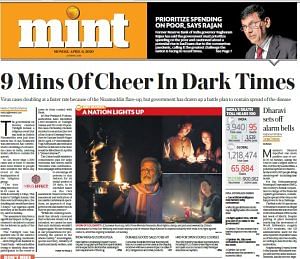 In “9 Mins Of Cheer In Dark Times”, Mint expands on the “dark times” and contrasts it with a photograph of the PM lighting a lamp. “Public health experts have said that the situation may spin out of control, if social distancing measures being put in place by the government are not adopted strictly,” it reports.
In “9 Mins Of Cheer In Dark Times”, Mint expands on the “dark times” and contrasts it with a photograph of the PM lighting a lamp. “Public health experts have said that the situation may spin out of control, if social distancing measures being put in place by the government are not adopted strictly,” it reports.
The paper calls Mumbai’s Dharavi, one of the largest slums in Asia, a “ticking time bomb”. In a similar report to Mumbai Mirror (‘Dharavi sets off alarm bells’), the paper says another case was detected in the area, taking the total to 5.
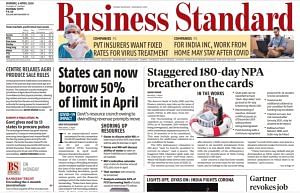 Unlike ET’s distressing lead delivers some hopeful news on the financial state in states. In “States can now borrow up to 50% of limit in April”, the paper reports the Centre’s decision to allow states to avail up to 50 per cent of their 2020-21 (FY21) borrowing requirements in the month of April itself which is sure to provide relief.
Unlike ET’s distressing lead delivers some hopeful news on the financial state in states. In “States can now borrow up to 50% of limit in April”, the paper reports the Centre’s decision to allow states to avail up to 50 per cent of their 2020-21 (FY21) borrowing requirements in the month of April itself which is sure to provide relief.
Like Mumbai Mirror and Mint, the paper notes the situation in Dharavi in its anchor story. In ‘Dharavi holds its breath as coronavirus cases spill over’, it identifies overcrowding, the presence of large families and unsanitary conditions as many reasons why the “teeming shantytown” is at a major risk.


